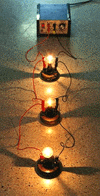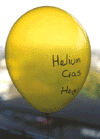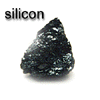| Metals
and non-metals
An element is a substance composed of one type of atom
only. There are 92 naturally occurring atoms, and hence the same number
of elements, that make up our Universe. The properties of the elements
are described by measures such as state, lustre, malleability, colour,
melting point, boiling point, density, electrical and heat conductivity
and the type of ions they form.
When these measures are applied to the elements they fall
into two main camps with a few elements with "a foot in both camps!"
This topic investigates the two main types of elements and how to tell
them apart.
Measuring
the elements
For simplicity four properties will be tested in
this section to divide the elements into their respective camps: state,
lustre, malleability, electrical conductivity and ion formation.
State: (solid, liquid or gas)
- gas - 11 elements
- liquid - 2 elements
- solid - 79 elements
Lustre: (the ability to reflect light
when polished)
- Reflect light well - 75 elements
- Do not reflect well - 17 elements
Malleability: (the ability of a solid
to be beaten into a sheet and to bend)
- Bend when hit with a hammer - 69 elements
- Break or shatter when hit* - 23 elements
* Note: Gases and liquids are included here.
Electrical conductivity: (will pass or
conduct an electric current)
- Good conductors - 68 elements (approximate figures)
- Poor conductors - 16 elements
- Semiconductors - 8 elements
Ion formation: (atoms either gain electrons
to form negative ions, lose electrons to form positive ions or do not
easily form ions at all.)
- Form positive ions - 73 elements
- Form negative ions - 7 elements
- Do not easily form ions - 12 elements
The above measurements show that the majority of elements are lustrous,
malleable solids that form positive ions and conduct electricity.
 Metals Metals
In fact, the above statement is just about right as the description
of the type of elements called "metals".
There are 71 naturally occurring elements recognised as metals.
- All conduct electricity well
- All conduct heat well
- All have lustre
- All form positive ions
- All, but one are solids (mercury is a liquid)
- Most are quite malleable and ductile (the ability to be drawn into
a wire)
Typical metals are: gold, silver, mercury, iron, aluminium, lead, zinc,
chromium, uranium magnesium, calcium and copper to name a few.
Well, what about the other 21 elements? Lets try the opposite properties
of metals.
Non-metals
 Most are not solids, but liquids and gases. They do not conduct electricity
or heat well, are dull, form negative ions and shatter if hit with a
hammer (solids only).
Most are not solids, but liquids and gases. They do not conduct electricity
or heat well, are dull, form negative ions and shatter if hit with a
hammer (solids only).

There
are about 16 elements which have most of these properties. 11 are gases
and 1 liquid. 10 commonly form negative ions and 9
- Only 1 conducts electricity well, 9 do not 6 are semi conductors.
- None conduct heat well.
- Most are dull with no lustre, but there are 6 with lustre like
a metal.
- Only 1 forms positive ions easily, 7 form negative ions and 13
either will not form ions or do so only occasionally.
- Only 4 are solids, 11 are gases and 1 liquid.
- None are malleable or ductile.
Typical non-metals are hydrogen, helium, oxygen, sulfur, chlorine,
nitrogen and phosphorus.
Metalloids
Defining non-metals is not as easy as metals, because there is such
a large range of properties. One group of elements in particular borders
in properties between the metals and non-metals. Known as metalloids,
these are the elements with "a foot in both camps".
 The
number of metalloids is not well defined, probably 5 - 7 depending on
who you talk to! The
number of metalloids is not well defined, probably 5 - 7 depending on
who you talk to!
Metalloids, typically, are poor conductors of electricity (semi-conductors)
form either positive ions or none at all and are not malleable, but
most have the metallic lustre. This important group of elements has
among its members, silicon, arsenic, boron and selenium.
See the related web topics for more information on the exciting world
of the elements.
|